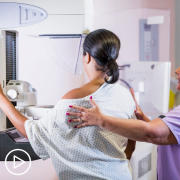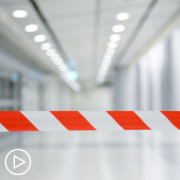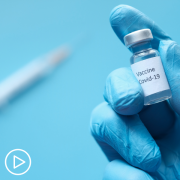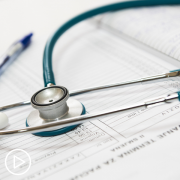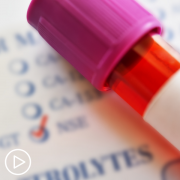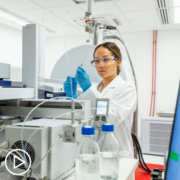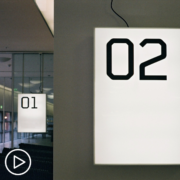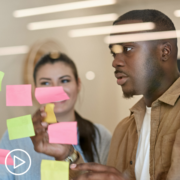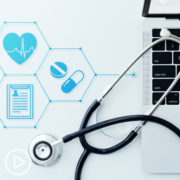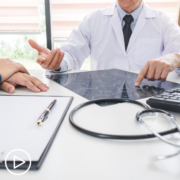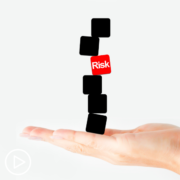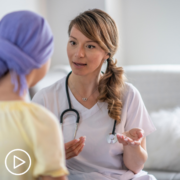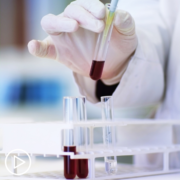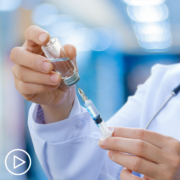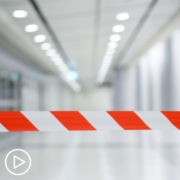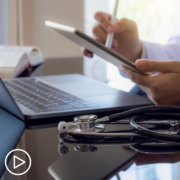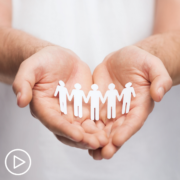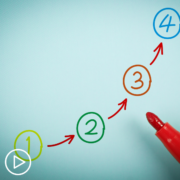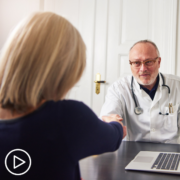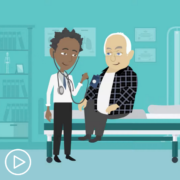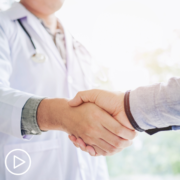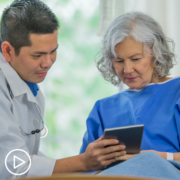How to Play an Active Role in Your MPN Treatment and Care Decisions from Patient Empowerment Network on Vimeo.
How can you play a role in your MPN care and treatment decisions? Engaging with your healthcare team is essential and may lead to better overall outcomes. In this program, Dr. Naveen Pemmaraju provides tips for how best to advocate for yourself or a loved one, as well as tools for making treatment and care decisions.
Dr. Naveen Pemmaraju is Director of the Blastic Plasmacytoid Dendritic Cell Neoplasm (BPDCN) Program in the Department of Leukemia at The University of Texas MD Anderson Cancer Center. Learn more about Dr. Pemmaraju, here.
Download Guide
See More from Engage
Related Programs:
Transcript:
Katherine Banwell:
Hello and welcome. I’m Katherine Banwell, your host for today’s program.
Today, we’re going to explore how to engage with your healthcare team when diagnosed with a myeloproliferative neoplasm, and we’ll discuss the patient’s role in care decisions.
Before we get into the discussion, please remember that this program is not a substitute for seeking medical advice. Please refer to your healthcare team about what might be best for you.
All right. Let’s meet our guest today. Joining me is Dr. Naveen Pemmaraju. Dr. Pemmaraju, would you please introduce yourself?
Dr. Pemmaraju:
Well, thank you for having me, Katherine and team. I’m Dr. Naveen Pemmaraju. Associate Professor of Leukemia and the Director of the Rare Disease Program with Blastic Neoplastic Cell Neoplasm (BPDCN) here at MD Anderson, and I’m happy to be here with you guys.
Katherine Banwell:
Thank you so much. We’re glad to have you with us today. As we move through this conversation, we’ll talk about the classic myeloproliferative neoplasms: essential thrombocythemia, polycythemia vera, and myelofibrosis.
But before we get into our discussion, let’s start with the question that’s on the minds of many of our audience members. We’re all hearing that the COVID-19 vaccine is safe, but how effective is it for MPN patients?
Dr. Pemmaraju:
Well, I believe that this is one of the most important issues of our time.
I think the way I would approach the COVID-19 question is, one, is we know that if our patients contract the virus, that can be deadly in actually many of our patients. So, I think it’s actually important to remember that the virus is still out there and that getting the virus is potentially very life-threatening, not only for the general population but for our patients.
For the vaccines, I kind of have two stories to tell you. So, one is my own anecdotal experience in the clinic where it has been surprisingly and remarkably well-tolerated in most of our patients. This is both the mRNA vaccines and as well as the J&J vaccine. And so, overall, we’ve seen a very minimal amount of allergic or other reactions.
I think the most important part, as you said at the top, is for specific medical advice, we need to be talking to our own providers. But I think for our MPN patients, we’re giving some caution, looking at the blood counts, what chemotherapy folks are on. But, in general, I’ve been happy with that rollout.
Now, for the effectiveness of them, sure. That’s a question of ongoing research. There are some data that’s coming out, particularly in CLL and other leukemias that – correct – maybe some of our immunocompromised patients, as you would expect, may not be able to mount the appropriate response. But all that data is moving and fluid, so we’ll see.
And then I think the other point here is with this question of the virus itself and maybe some of these vaccines having a signal for increased blood clots or coagulopathy.
This is something I think we have to follow in our MPN community only because our patients are already at a high risk for both bleeding and clotting. So, the virus itself, COVID-19, post-syndrome coagulopathy, possible side effects – idiosyncratic and rare, for sure, from these vaccines that can lead to a vaccine-induced thrombotic state. I think these are some of the factors that we have to watch out for. So, in general, we don’t yet know the exact answer for each patient, PV, ET, MF, how effective the vaccine may be. But we are encouraging everyone to go for it unless there’s an obvious contraindication. Katherine?
Katherine Banwell:
Okay. Good. Thank you. Let’s learn a little bit more about the disease itself. Dr. Pemmaraju, do a level set with our audience. Can you help us understand the differences between ET, PV, and MF?
Dr. Pemmaraju:
Yeah, this is very important because we toss these words around as if there’s some big definition that was given, and oftentimes, that never happens. So, let’s pause to do that. So, this goes back to the 1950s when William Dameshek, who really postulated the modern MPDs at that time as they were known – myeloproliferative disorders – really thought that there were four diseases that were similar at some level and then presented differently. So, that’s polycythemia vera, essential thrombocytosis, myelofibrosis, and CML, chronic myeloid leukemia.
Then, as the modern era comes in, CML is divided off because of the Philadelphia chromosome, BCR-ABL, which is present in 100 percent of those patients.
So, now we know CML is its own thing. And now we have the big three, sort of non-Philadelphia chromosome MPNs, as they’re now known, because neoplasm – cancer – instead of disorder. Within the subtype, and this is important, the subtypes that you mentioned are the most common.
So, polycythemia vera – poly meaning many, cythemia, cells, vera is Latin for true. This is the designation for the patient who has a higher than expected blood red cell mass or hematocrit. And it actually, interestingly, Katherine, most patients with p. vera have an increase in all three of their blood lines, so the red cells, hemoglobin, hematocrit, platelets, and white count. Those patients with PV are especially at risk for both bleeding and clotting, transformation to myelofibrosis, and even transformation to acute leukemia in maybe 5 to 7 percent of patients.
So, the usual treatment there, Katherine, is to bring off the blood mass. That’s the phlebotomy. And then in the patient who is above the age of 60 or has a prior blood clot, to give some form of chemotherapy, hydroxyurea (Hydrea) or interferon, for example.
Now, the second grouping is ET, essential thrombocytosis. Again, this word vera or essential, meaning not reactive, not benign, not from a regular cause like a surgery or a trauma or an inflammation. So, it means a cancerous cause, an autonomous cause, something that’s coming on its own.
Thrombocythemia or thrombocytosis, meaning too many platelets. So, usually, patients with ET have too many platelets as their predominant manifestation. But again, as with p. vera, patients can get into problems with that. Very, very high platelets, usually a million and a half or higher, can actually lead to bleeding. Not necessarily clotting, but extra bleeding. And then patients with any platelet levels, because the platelet level doesn’t exactly correlate, can have either bleeding or clotting. So, that’s usually the predominant factor. And again, the underlying problem with these MPNs is that they can transform to the other ones – PV, MF, even acute leukemia.
And then, finally, myelofibrosis, which we could spend the whole hour on just by itself, is the more advanced state out of these. So, it can either arise out of the PV or ET or stand alone. And really here, this is an advanced bone marrow failure state with bone marrow scarring or fibrosis. And now, usually, most patients, their blood counts, rather than high are now low because the bone marrow is unable to produce enough cells. And then, therefore, the sequela of the disease – anemia, thrombocytopenia. So, low blood, low platelets.
Then you need transfusions. The liver and the spleen get larger because they remember how to make blood cells. People can have a wasting away appearance. And then here, more than the PV or ET, this is more of an acute disease for many where if you have intermediate to high stage, these patients can transform more readily to leukemia and have a decreased overall survival.
Katherine Banwell:
When a person is diagnosed with an MPN, they have a whole healthcare team. Who is typically on that team?
Dr. Pemmaraju:
Well, it’s interesting. Yeah, that’s evolved over time.
It used to just be patient and their local oncologist, right? And the oncologist office has become a very busy place with mostly solid tumors. So, breast, prostate, colon, and then maybe a few scattered patients in most practices with blood cancers. Obviously, blood abnormalities are common with platelets and anemia and all that, but to actually have an MPN patient in the general hem/onc practice is actually quite rare. Right? These diseases are 4 to 5 out of 100,000 people.
Now, fast-forward to the modern era. I think this is important. I think now, what I personally encourage – and obviously I’m biased because I’m here at the academic center. But I really think that patients with rare blood cancers such as MPNs should be co-managed. So, be seen by your local hematologist/oncologist, for sure. They know you the best. But also have a referral, if you’re able to and have the resources and ability to travel, to an academic center where you can see a blood cancer specialist such as me or my colleagues, as I only focus on blood cancer.
So, I’m not seeing patients with a solid tumor. So, local oncologist. If you can have a blood cancer expert as part of your care, it doesn’t have to replace the care. And then to have a member of the nursing allied professions – nursing and APP, advanced practice providers – is really becoming essential to help with acquiring the prescriptions from the specialty pharmacy, prior authorizations, teaching of the injectables, such as interferon, figuring out enrolling on clinical trials.
So – and then, if a patient, young and fit, with myelofibrosis, you’ll want to be consulted with a stem cell transplant doctor. And then, finally, as if that wasn’t enough, I think a good pharmacist team is important nowadays to go over the drug-to-drug interactions, side effects. It’s not just about the JAK inhibitors but all the other medicines – antibiotics and everything else – that may be a bit unique to the MPN patient compared to the general cancer patient.
Katherine Banwell:
Right. Lately, we’ve been hearing this term “shared decision-making,” which basically means the patients and clinicians collaborate to make healthcare decisions. And it can help patients to take a more active role in their care. So, I’d like to get your thoughts on how best to make this process work.
Dr. Pemmaraju:
This is a passion area to me. I think this is so important that you bring this out. I think a generation or two ago, Katherine, it may have been common for there to be more of a one-way monologue, if you will, doctor to patient, and that may have been the majority of the conversation before.
I don’t see it that way anymore, and most of my colleagues don’t either. I think it should be a dialogue, as you said. It should be a back-and-forth communication, one that learns and evolves over time as any real relationship would, right? Outside in the real world. So, I think that’s important. Number two, I think trust needs to be earned, not just given.
So, that means patient and physician, and really the physician team – so, all the other members of the team – building that trust over time through frequent communication, visits, all of this. And then, finally, I think the key here is that a lot of patients always ask, “Hey, what can I do on my own?” I’ll tell you what you can do. You can be involved and read and empower yourself if you’re able to, if you’re able to and you can. Many may not be able to due to their illness or for other reasons.
But if you are able to, I think it’s great to read online. There, I just said it. Let me repeat it to make sure everyone heard that. I want you to read. I think it’s fine. Consult Dr. Google. What’s the worst that happens? The worst that happens is you find misinformation. Well, don’t keep it to yourself. right? So, Google, look up things, go to social media, see what experts in your area are talking about, go to Facebook, go to the patient groups. But remember, everyone’s case is different. Someone else’s is different from yours, and yours is different from the next. So, gather information like a sponge.
Formulate it, synthesize it in the way that only you know how to do, bring some notes, and then talk about it with me at the next visit, “Hey, I saw this on the Internet.” “Okay, great, let’s talk about that.” Or, “Hey, this new formulation of interferon is coming.” “Great, let’s talk about it.” So, gather information, sort out signal from the noise with your healthcare team. Sort that out and then move on, move on, move on. So, I think these are some of the aspects of what’s called shared decision-making. No longer a monologue, one-way street. Let’s have a dialogue, let’s have a partnership, let’s figure out a way to empower each other in this journey.
Katherine Banwell:
We’re going to talk in a few moments about online research and how well that works or how well it doesn’t. But let’s talk about treatment goals first for ET, PV, and MF. What are the goals of treatment from a clinical perspective?
Dr. Pemmaraju:
Well, I think the goals are divided up into three factors. So, I think for the MPN patient, goal number one has to be what the patient themselves want to achieve.
Oftentimes, that’s different than what’s on the numbers with the labs and what the physician wants. So, I think a lot of our patients correctly are suffering from – or mentioning to us that they’re suffering from quality of life issues. So, fatigue is the most common manifestation of all the MPNs, followed by bone pain, night sweats, inability to concentrate, etcetera, etcetera.
So, I think quality of life is the goal of most people, and I think that’s an admirable goal. And some of the medicines can help that. Some can actually hurt that in the short term. So, let’s put that as bucket number one. What does the patient want to achieve? Usually, it’s the alleviation of fatigue, itching, bone pain, etcetera.
Number two, I think, is the sort of on-paper game, if you will, right? So, what do the labs show, what does the bone marrow biopsy show, what does the spleen show? I think all of that is good, too, in that bucket. And clearly, if someone has transfusion dependent anemia, two times a week needing blood transfusions, and whatever treatment you can do can alleviate that down to once a week, once a month never – okay, that’s a win for the patient.
And then I think, finally, our goals. You’re right. You asked me specifically “What are my goals for our patients?” Well, I want to see that your overall survival has improved if I can. So, your length of life, your quality of life has improved, minimization of side effects from whatever therapy we’re doing. If we’re going on a clinical trial or combining therapies in a novel way, that you’re not experiencing some brand new or idiosyncratic toxicity or side effect.
And then, finally, I think the key is to monitor for, let’s say, other things. Are you developing a second cancer, a second blood cancer? Are you having another problem that’s outside of your MPN, such as iron deficiency anemia or thyroid disease? Something that’s extremely common, has nothing to do with the MPN, but is also happening. And then do you have a healthcare team?
I failed to mention in your earlier question the primary care doctor, right? Let’s mention that person as well. If our patients have the general practitioner who they had already been seeing before the MPN diagnosis, or at least established one after, then some of these important aspects, like cancer screening, cholesterol checks, some of these other important things can be done in parallel to the MPN therapy and then, of course, combined at different points.
So, these are kind of my benchmarks for goals of therapy. They will vary from patient to patient and, of course, from case to case. The patient with advanced intermediate to high-risk myelofibrosis going to transplant, well, that’s markedly different from the patient who’s young with ET with no blood clots and relatively controlled blood counts. So, different goals there, Katherine.
Katherine Banwell:
Right. Right. So, you just mentioned a couple of factors that you take into consideration, but there are others as well, I think. What about the patient’s age and overall health, for instance?
Dr. Pemmaraju:
Could not be more important. You’re right. I think age – and let’s use that as a surrogate for what we call ECOG performance data. So, the overall kind of fitness of a patient, as you said, may be the most important factor. And then followed by these other conditions, so-called co-morbidities. I’d like to talk about that for a second because that’s a lot of the program here. Depending on a patient’s age, performance status, fitness, and other organs that are involved, that actually leads to a couple of important points.
One, it may limit or reduce the number of treatment options that a person has based on their ability to even tolerate it in the first place. Both oral chemos that are available, some of these clinical trials that need to use an IV drug.
Number two, it may predict how your overall survival is going to be. So, perhaps your MPN, as we used in the other example, you have an earlier stage MPN that really doesn’t require treatment. It requires active observation.
But then on the other hand, you have advanced heart disease or kidney disease. That may actually do you more harm in the end. So, that’s actually very important that you bring that up.
And then, finally, right, is this concept that you have the co-morbidities and then you have the MPN, and then they kind of change and morph over time where one is the dominant issue, the other isn’t. And so, you do need that decision care team as you were mentioning earlier. So, let’s definitely say that out loud that that matters. And I think it also reminds us that nothing is in a vacuum. The MPN doesn’t exist in an isolated space, right? So, your MPN co-exists with your heart disease, your kidney disease, your lung disease, your past, your present habits, anything.
Katherine Banwell:
Exactly.
Dr. Pemmaraju:
So, I’m really glad you brought that up. And I think also, to your point with the shared decision-making model, I think sometimes, as physicians, we may not ask, and as patients, we forget to mention, “Oh, X, Y, Z in my history,” or “Oh, I’m taking this herbal supplement.” Sometimes these things are important to mention.
So, when in doubt, bring up everything to your care team so that you can make decisions together.
Katherine Banwell:
Right. It might help to make notes before you go in to talk to your doctor.
Dr. Pemmaraju:
Sure. Sure, absolutely. That doesn’t hurt, and it could help you at least organize your own thoughts even if you don’t use them in the visit.
Katherine Banwell:
Exactly. Yeah. Dr. Pemmaraju, let’s talk about biomarker testing. Can you help us understand what biomarkers are and how they may affect treatments?
Dr. Pemmaraju:
Yes. Biomarkers – I think that word gets mentioned a lot with really no definition, because it’s one of those words that can be whatever someone wants it to be. So, you’re right. For us, it’s a very important word in MPN. Bio meaning of life, scientific, and then marker meaning some kind of a measuring stick that has a value.
Well, there are two ways to look at biomarkers. One is the obvious, which is we have the defined big three molecular mutations. So, that’s JAK2V617F, followed by CALR mutation, followed by MPL. Those are the big three. Those make up about 90 percent of all patients with MPNs. You’re technically not born with them, although new data suggests that you may acquire these mutations right after birth. So, those markers are important, because they can be used to diagnose the disease, right? Particularly in the challenging patient. They have high platelets, you can’t tell if it’s reactive or ET. Okay, so they’re helpful with diagnosis.
Maybe some studies have shown that some of these markers can be predictive, Katherine, of blood clots. Let that research be ongoing. And then, obviously, some of these may be helpful in terms of designing the future treatments, particularly targeted therapies. So, I think biomarkers are part of our field, if you look at it that way, at diagnosis and risk stratification prognosis. But there are other factors that are starting to come out. One is there are molecular mutations outside of these big three.
So, outside of JAK2, CALR, and MPL, that are very important actually. Not everyone is checking for them. They are ASXL1 mutations, EZH2, IDH1 and 2, so on and so forth.
So, these are extended molecular markers that can be checked at some doctors’ offices that now, in the latest scoring systems, if you have one of those or more than one or two, they can elevate your risk score. So, if you have low-risk or intermediate-risk myelofibrosis, they may make you intermediate or high risk.
So, that may be a bit more complicated than what most people are aware of. But just so you know, there are markers that can be readily checked that can tell if your disease may be a bit higher risk than we though, say, 10 years ago.
I think other biomarkers that we look at are some of the labs that are just the regular labs that are on almost every panel, but they can tell a lot about the disease. There’s the LDH, lactate dehydrogenase. There are several markers, such as CRP and sed rate.
So, anyway, there are a lot of labs that we can check depending on where you are in your disease state that can kind of tell us a lot about how inflamed you are, how active your disease is at the moment, and then that will lead to further confirmatory tests. So, I think, yeah, in general, this is an active, developing area of research in our MPN field.
Katherine Banwell:
It seems like results could really influence therapy choices then. So, do you think patients should ask for these tests specifically?
Dr. Pemmaraju:
I’m a big fan of patients being empowered to ask anything that comes to mind. And again, that’s why I love this discussion because maybe there might be some people out there who are shocked, frankly, at what we’re talking about here. I think it’s great to do what you said. Yes. I think do your research, online or otherwise. Come up with a list of questions. Bring – if you’re able to, of course – if you have the ability to, bring one person with you. Or nowadays, on the telehealth, we put one person on through the phone during the pandemic time.
And then – yeah. I mean, yeah, sure, just you hear about something, ask about it. The worst thing that your doctor says is, “Hey, that’s only a research test. That’s not available.” It doesn’t hurt to ask. And it may help to lead to other discussions. I think it’s also a good idea to get a second or a third opinion if you need to. There, I said it. It’s your body, it’s your life, it’s your choice. I think, yes, advocate for yourself, because at the end of the day, who else is going to do that?
Katherine Banwell:
Absolutely. Dr. Pemmaraju, are there other questions that patients should consider asking about their proposed treatment plan?
Dr. Pemmaraju:
You know, I think the biggest thing that I think is getting left out in the rare blood cancers that I spend all my time in is the ability and access to clinical trials. And that’s one thing I wanted to discuss with you this morning, which is you’re seen in your local doctor’s office. They’re doing the heroic work, and I really think it is, of seeing breast cancer patients, prostate, lung, colon, PV.
It’s just the difference between the frequent, common tumors that get chapters dedicated to them in the board review testing and whole months dedicated in the oncology fellowship compared to the patient with the rare blood cancer that, really, you may only encounter once or twice in your career. As compared to, say, me, where I’m a specialist in only that area.
I think that we – look, here’s the deal. Even today, only 5 to 7 percent of all oncology patients are ever referred to – are ever enrolled on a clinical trial. Clinical trials oftentimes are seen as last resort, last ditch. And I understand that. In fact, I even thought that before I went into medical school.
Then once you get to this point where I am, you realize, wait a second, clinical trial, oftentimes, are frontline programs. Yes, sometimes they’re randomized, sometimes they’re not. Very few times does anyone get placebo, right? Which is what a lot of people are worried about. Or if they do, it’s two drugs versus one plus placebo. Anyway, so there are a lot of different things that are clinical trials.
But we realize now that oncology has so little known information still in 2021 and beyond. So the ability to enroll in a clinical trial, be referred to it, travel to it, know about it, get on it, you’re contributing so much information to not only yourself and patients in your cohort but possibly for the future. So, that’s my only plug, is I wish that we would all ask each other more about “What clinical trials are available, how do I look them up, do you recommend this for me, or can I figure out with you how to travel and do all that stuff?”
So, I think clinical trials in rare blood cancers such as MPNs are underutilized, under-referred to, under-thought of. And then even when we are able to get people there, Katherine, it’s difficult to keep people traveling, particularly vulnerable people.
Katherine Banwell:
Yeah. We have a question from a newly diagnosed PD patient. Sharon says, “I’m just about to begin Jakafi. What can I expect?”
Dr. Pemmaraju:
Yeah, great question, right? So, with ruxolitinib or Jakafi, I think the biggest couple of points here is, for what’s known, this is the first-in-class JAK inhibitor that we have the most experience with.
So, now we have over a decade-plus of experience. I guess general things are general, right? This is not specific medical advice. That’s not the intention of this program. But, in general, I would stick with what’s on the package label insert, and there are a couple things we know.
One is this is a highly effective drug. This drug, which we have tested now in multiple, multiple, multiple different trials in myelofibrosis, polycythemia vera, now approved in a form of graft-versus-host disease, different doses. So, I would say check the dose for your particular disease and indication. Double-check it with your pharmacist. Make sure there are no drug-to-drug interactions.
Number two, I think what’s important is that some patients on this drug can experience immunosuppression. So, that means that you may be at risk for some infections, and there’s some nice literature about that.
So, check with your doctor about that, particularly reactivation of old infections, looking out for viral infections, such as herpes zoster or shingles. And then I think the other key here is to watch out for the modulation of your disease. So, a lot of folks have big spleens, Katherine. Those shrink down. Then patients get their appetite back, they’re able to eat, and so some people can have weight gain that then goes the other way. So, these are some of the things you want to watch out for.
But, in general, read the package insert. If you have the ability to, it’s worth reading the – if you can, read the paper, right? Go read the New England Journal paper or – if you can look at that. And then make sure you talk to your local pharmacist and ask the same question there. You might be surprised at some tidbits and pearls you can pick up.
Katherine Banwell:
Right. Once on therapy, how is the disease monitored, and how do you know if the treatment is working?
Dr. Pemmaraju:
Yeah. So, it differs from each disease, but let’s take polycythemia vera for a good example. So, let’s suppose you have polycythemia vera. I think there are three markers here that you can check. One is the blood counts, right?
So, you want to make sure that the blood counts are controlled. New England Journal, five or six years ago now, our Italian colleagues published a very seminal paper which shows that the goal of therapy should be that the hematocrit should be below 45. So, that’s actually a very nice number to have. So, not just waiting for symptoms of the disease but keep the number low. And if you do that, that correlates with decreased cardiac events, thromboembolic events.
Number two, I think that, besides the blood count, the spleen. The spleen and liver size also is a nice surrogate for how the disease is doing. So, if that’s enlarging or getting out of control, that may be time to stop what you’re doing, reassess. The disease may be progressing to myelofibrosis, for example.
And then I think, lastly, the absence of stuff actually helps, too. So, the absence of major bleeding, the absence of blood clots, the absence of transformation to MF. I think if the quality of life is good, you’re decreasing blood clots and bleeding, you’re not going to a more advanced disease state, these are all wins for us with p. vera.
Katherine Banwell:
You touched on this briefly, but I’m wondering when a patient should consider changing treatments.
Dr. Pemmaraju:
Yeah, changing treatments is more art than science, I would say. So, it does – that’s one of those that is kind of specific from patient to patient. In general, what we just talked about gives you that guidance. So, in polycythemia vera, since we brought that up earlier, uncontrolled blood counts despite maximum medication intervention, the phlebotomy requirement being untoward and impossible to keep up with, the spleen size growing out of control, the quality of life being impossible – these are some aspects to look into changing therapy and/or clinical trial.
But remember, it’s not a one-size-fits-all, right? So, some patients, the counts – some of these things may or may not actually play out. So, it has to be more of a gestalt, more of a total picture there.
Katherine Banwell:
Yeah. Why is it so important for patients to speak up when it comes to symptoms or treatment side effects?
Dr. Pemmaraju:
Well, I’m going to be that magician who you watch the TV show, they give away all the secrets. So, this is the big secret. Your doctor cannot read your mind. I hate to say that, Katherine. I just said it here, and it’s going to surprise some people. No, I mean, seriously. Right. So, I think the problem with the MPNs – not the problem, the caveat, the difficulty – is if you are a patient, you have this war that’s suffering inside of you. I know that as an expert person. You know that as a patient. But whoever you’re sitting in front of is not going to know that.
And there are two reasons for that. One is you don’t look like that. Most of our patients – whatever this is, I’m going to put this in big air quotes, so in case someone’s not watching this and they’re only hearing, I’m putting air quotes. People say to my patients, “Wow, you don’t look like a cancer patient.” Whatever that means, right? So, most of our patients don’t have their hair falling out, etcetera, etcetera. So, there’s that aspect of it, the visual education part of it.
Then there’s also the part, which is a lot of these symptoms burdens are not obvious on the physical exam. You cannot tell by talking to someone or looking at them if they have night sweats, bone pain, even itching, any of these things. Fatigue. You can’t tell if someone has fatigue most of the time unless you ask them. So, this is one of those where shared partnership in decision-making is not just a generic phrase. This is important.
I would say that for a patient with an MPN, the MPN symptom burden – the questionnaire, the 10 questions that we now have settled on – that can tell so much more or as much as the physical exam or the blood counts.
So, it’s imperative. It’s not just a luxury. It’s imperative. And if the patient themselves is unable to speak up, then if the advocate or caregiver or loved one can, if that person is available.
The other point I would say to this is that oftentimes the symptoms can precede – they can come before laboratory changes, physical exam changes, all these things. So, a constant, constant communication, “Hey, I was playing 18 holes of golf last year.”
“Now I can’t even get out of bed.” Hello? That tells you more than almost anything you can read on a piece of paper. So, you, as always, are spot-on with what you said. And this is the case where people say, “What can I do to help my care?” This is it. Speak up, speak out. It’s your body, it’s your life, make sure you feel empowered to do that.
Katherine Banwell:
Right. It’s important to have that dialogue. Dr. Pemmaraju, you’re very active on social media, and patients often share information with one another. So, what advice do you have for patients to ensure online sources are actually credible?
Dr. Pemmaraju:
Wow, great question. First thing I would say is I encourage everyone to get out there, so that’s key opinion leaders, local physicians, nurses, pharmacists, patients, caregivers, everyone. But Part two is what you said is true. Most everything out there is noise. It could be garbage. It could be background. It could be misinformation. So, you do have to have some way to filter it.
I call it signal from the noise. That’s a common phrase that a lot of people on social media use. I guess three things that I would give as tips. One is don’t be afraid to read and get on there, but I would just say whatever you read, take it with a grain of salt, as you said, and just write everything down where you have it organized.
Number two, tend to gravitate towards known experts and known sources. So, for example, you mentioned that I’m on there. That’s great. Ruben Mesa, our great friend and colleague, etcetera, etcetera. So, if you know who the 10 or 15 thought leaders are on Twitter or social media, see what they’re saying directly. That’s nice, because it’s straight from them to the public.
And then three is stick with the organizations and entities that are trusted sources. New England Journal of Medicine, ASCO, ASH, programs such as yourself, etcetera, etcetera, who are trying to put out there the latest and honest information.
Okay. So, now the fourth part, though, I think is the most important, which is what we said earlier, which is whatever you look up, discuss it with your doctor and your physician team. Period. Because no matter what research you did, no matter what patients groups you join, there might be something that either doesn’t apply to you, or worse, as you said, it could be actual misinformation, and it’s a red herring.
So, maybe find information, figure out a way to filter it, cross-check it, and then bring it up to your doctor team. I think that’s a winning way for success with information nowadays.
Katherine Banwell:
Yeah. That’s really helpful information. Well, we have another audience question. This one is from Richard. He wants to know, what advice do you have for caregivers, and how can he be supportive during appointments?
Dr. Pemmaraju:
Yeah. Richard’s question really is so important. Really, before the pandemic and now with the pandemic this extended time, this is the most important question that’s coming up. This is a challenge. I think a lot of our patients who are older, frail, live alone, they don’t even have the option to do that. That may be 25 percent of our patients right there,
And that’s very heartbreaking and difficult, and clearly, their care – it may not be compromised, but it’s certainly limited in some ways without getting that other perspective, right? So, I think that’s important.
Now, out of the 75 percent of the people who may have someone that can be a part of their life, a lot of these folks, Katherine, are limited because of the pandemic. Most hospitals, smartly, I think, still have restrictions on not allowing every single person in the building just for health and safety protocols. So, telehealth has had to be a substitute, I would say, for that, and in a lot of cases, has been helpful. In some cases, frustrating, obviously, with technical difficulties, etcetera, etcetera.
I would say that the key is – and I really want this to be very specific. It would be easy to just say, “Yep, bring a loved one to your visit.” No, it’s not that easy, right? So, now, during the pandemic, I think two things are very important and what I’ve noticed. One is, if the patient is able to, if their health allows them to, prime the loved one or caregiver, “Hey, I’m going to be in the doctor’s office from this time.”
And I always say make it like the cable person visit, right? From 8:00 to 5:00. So, “Hey, today, on Tuesday, if you can have your cell phone on you, that would be nice, because I’m going to patch you in, and you can listen in the background.” This is actually a key pearl I can give to people. You’d be surprised how helpful that is. Because most people, if they’re not living in the same household or whatever – “Oh, I didn’t even know you were going to be,” – okay.
Number two, when the loved one or caregiver is involved, which I encourage for everyone, try to discuss with them the night before, if your health allows you to, to go over some of the key questions. Say, “Hey, guess what? I only understand about 7 to 10 percent of what goes on in these visits, but I need you to ask this.” So, you can kind of prime your loved one to do that.
And then, lastly, you had mentioned earlier to have this list of questions. Well, that’s a great thing to give to the caregiver, right? So, if you’re able to use email and your family member is in California and you’re in Texas, maybe a quick email the night before.
“Hey, here’s what I’m thinking. In case I forget, will you ask this to the doctor?” A lot of these visits may only be five or 10 minutes, but you’d be surprised, if you have a list of two or three questions – boom, boom, boom – and then it’ll alleviate those worries there.
Lastly, I would also say don’t feel – I want to tell this to the viewers out there. Don’t feel pressured when you’re in the visit with us that you have to get every single thing out. And what I mean by that is now with email and the electronic medical record portal systems, there is some ability to contact people during – I’m sorry, after and between visits. So, maybe that might help you to not feel so much pressure in the visit.
Katherine Banwell:
Yeah. Very good advice. Thank you. Before we end the program, have there been any recent developments in MPN treatment and research that make you hopeful?
Dr. Pemmaraju:
I have a lot of optimism and hope. It really blossomed over the last two years. I’m happy to report to our viewers – and this is incredible, I never would have predicted this. There are over 10, maybe 13, Phase 3 clinical trials that are in the clinic now or opening soon.
Phase 3 meaning sort of the latest – one of the latest stages of clinical trial development for new drugs. And a lot of these drugs are combinations. So, a lot of them, you’re on your ruxolitinib, for example, you’re on your JAK inhibitor, and then you add in the second agent. This is very exciting. I, myself, am leading or a part of several of these. I mean, we could have never envisioned this five years ago. So, not only these drugs have shown encouraging activity in the Phase 1 and 2 – so, the earlier stages – so, now we have to confirm and test them in larger trials. So, stay tuned for that, whether you can participate directly or at least follow along with the information.
And then the other piece of excitement is that there’s a lot of beyond JAK inhibitor drugs. So, that means novel pathways, new drugs that have nothing to do with JAK that can either stand alone by themselves or be combined. That’s another exciting area. We have multiple classes of drugs emerging from the lab into the clinic now that I hope will have a lot of benefit for our patients.
So, tons of optimism and excitement, frankly, that just wasn’t there five years ago.
Katherine Banwell:
That’s wonderful. Dr. Pemmaraju, thank you so much for joining us today.
Dr. Pemmaraju:
Thank you, Katherine. I just love the chance to spend time with you guys. I hope to do this soon one day.
Katherine Banwell:
And thank you to all of our partners. To learn more about MPNs and to access tools to help you become a proactive patient, visit powerfulpatients.org. I’m Katherine Banwell, thanks for joining us.
